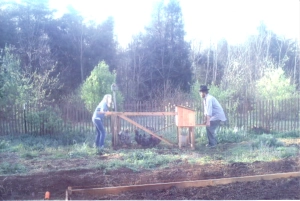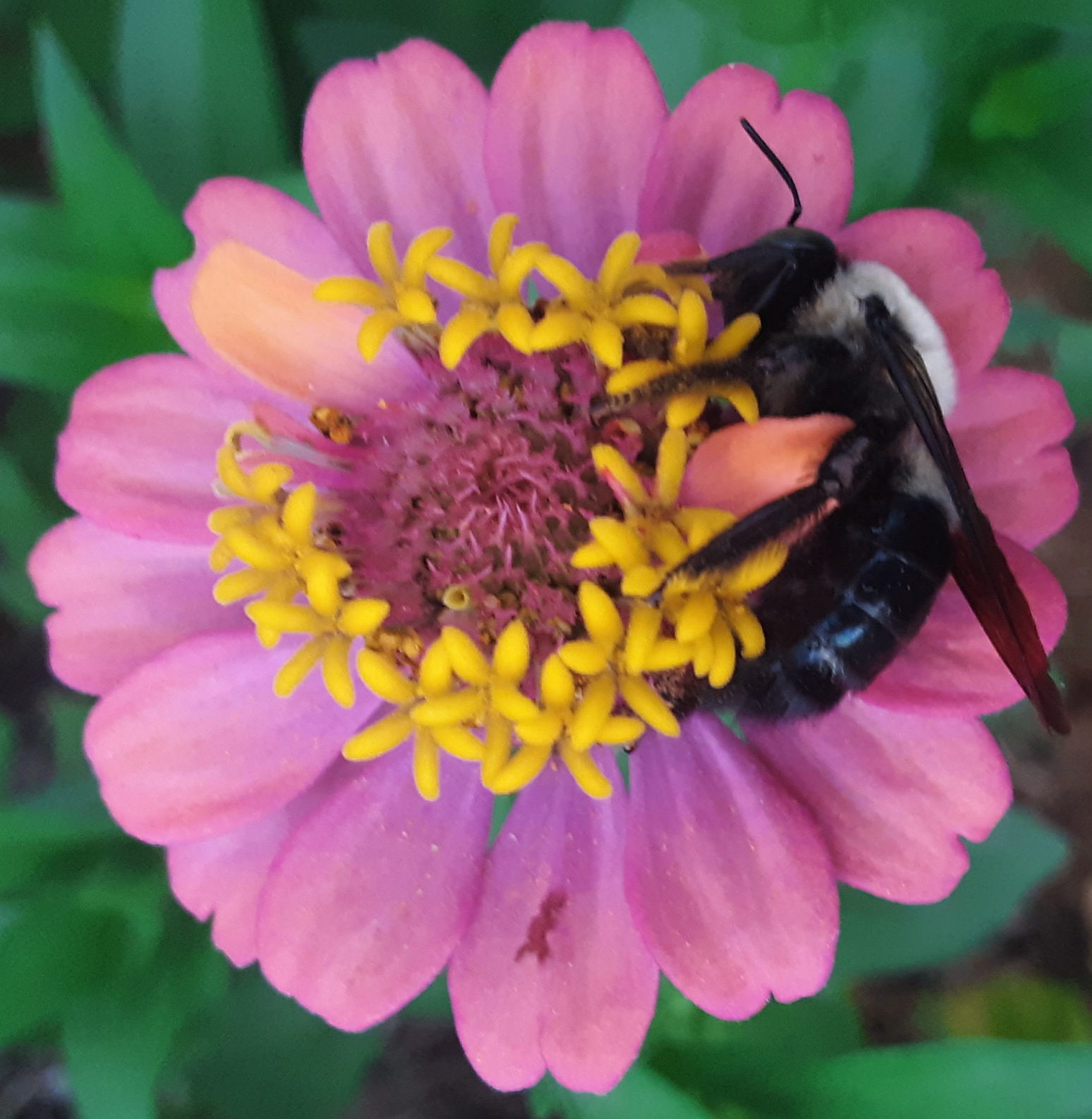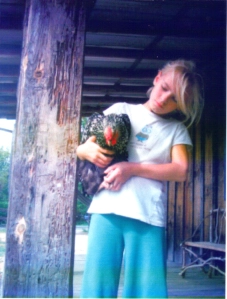
Jasmine with Cici
Ten or eleven years ago (now 25 years ago, Ed.), shortly after we moved onto our own acre in the country, I began to hear the phrase “chicken tractor.” Of course, if you do not know what this is already, the image it probably conjures up is one of a shiny, red, or green machine with big wheels.
I kept thinking that until a friend mentioned it again in a conversation regarding permaculture and I pressed for further definition of both terms. A ‘chicken tractor’ by my definition is a portable/movable pen in which may live one or more hens, roosters, and/or chicks. This allows them to be moved to fresh grass and insects while protecting them from most predators (although snakes, an exception, can usually penetrate most chicken tractors and coops). But snakes generally only eat eggs so they aren’t exactly predators, either.
Shortly after I began to think about adding some chickens to our organic little plot, I met a woman at a yard sale. Actually, the yard sale had been postponed, but we didn’t know and we were already there, so we struck up a conversation. She had an adorable daughter who actually was responsible for the birds, but since nothing was going on at the postponed yard sale, she invited me to her place to see her chicken set-up, so I followed her down to the little village island community of Gibbs Woods, North Carolina.
Once there, we saw happy birds, thriving gardens, and chickens in our future. We kept, promising to stay in touch, and let her know that we’d be happy to take a couple of extra birds if she had them. The very next weekend, we’d built our first-ever little coop, and chicken yard and we were proud parents of two hens: Heather (a Dominicker) and Harriet (a classic white Leghorn).
In the past ten (15, Ed.) years, we’ve gone without any fowl in the yard for no more than a year’s time. The last time, it was only because we ourselves did not have a finished home, so the birds were bumped down a few notches on the priority list. But, mostly we’ve decided that chickens, with their sweet clucking, timely crows, and fresh eggs, are NECESSITIES.
We quickly made the leap from two hens to 20 plus a few roosters. The ladies went broody (meaning they just wanted to sit on the eggs that were laid, ready to incubate them) and within a few more weeks (three, to be exact) it was ‘hello, cute fuzzy chicks,’ every Easter for several years.
The original chicken yard, unfortunately, proved ineffective in keeping out predators (its never a fun thing to find the carnage of marauding raccoons and possums in the morning) and our social lives were majorly dampened, due to having to be home every night by disk to shut the door after they all went in. This is when we ditched coops for tractors. Our next chicken building was built from a set of plans featured in “Countryside” magazine, and referred to as an “English Country Chicken tractor,” with two perches, a full-on nesting house, and an excellent ramp for even the less sure-footed foul.
This was much nicer than our first building, but it proved difficult to move and required two or three sets of hands to maneuver it off depleted parts of the lawn, so we decided to park it and try deep mulching/bedding…this meant transporting an enormous “porch enclosure” someone was giving away in my parents’ rather nice suburban neighborhood, precariously perched atop our F150 for the 45-minute drive down to Pungo (our place).
This porch enclosure was free and actually more like an aviary, even though the person giving it had designed it for their cat so they could go out on the back deck without escaping. The hens continued to live in their fancy English house, and we added occasional straw, hay, compost, plant matter, and occasional oyster shells, shoveling it out once it was depleted for the fresh matter.
The system worked well for about four or five years, and the last time we saw it, almost ten years after it was put in place, there were still at least a dozen happy healthy thriving chicks. I almost wish we could have moved it with us, three hours west, but that would have been like moving a small house, really.
Here in Scottsville, we’ve built so many chicken tractors, I cannot remember them all…We went back to a coop situation (which the chickens do love, but was still not foolproof against possible foxes, weasels, and other small mammal predators.) We’ve also made triangular pens that were too light (and could be lifted by dogs) and straw bale chicken tractors (nice in theory, difficult in practice unless you are only raising chickens short-term for meat).
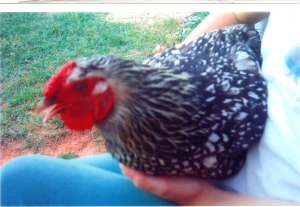
J holds Cici the Dominicker
Since hens are allowed almost everywhere (check your town or county’s health codes…or not), I do not know why everyone does not keep a few birds in their backyard. We’ve also had ducks and guineas but found them to be more difficult. We’ve yet to host turkeys or peacocks here, mainly because our interest is centered on eggs.
Children are hooked once they find their first egg, still warm, from underneath a hen. And watching a mama tend to her baby chicks is one of the sweetest versions of love you will ever witness. Occasionally, we’ve had roosters that sounded more like drunken fans at a Lynrd Skynrd show, but for the most part, any time we’ve had the ratio of about ten hens for each rooster, things have gone well We get their eggs, and entertainment.
Ultimately, a movable pen that is about waist high, at least four feet in width and eight feet in length, and tightly covered with chicken wire is the basic design we return to because it is safe, easily movable by anyone, and a good size to set on top of garden areas.
Additionally, if you want to clear a patch from weeds or lawn for a future garden, or a messy plot, a chicken tractor full of hens cannot be beaten. They work systematically and joyfully on all but the hottest days for free until the job is done, and will keep providing the service with little more than additions of straw, food and drinking water.
Whether you buy or build a chicken tractor, or a coop, or a straw bale structure, be sure to include a perch or two…like most birds they like to feel like they are nestled on a nice limb of a tree, even if they are only three feet off the ground. Any stick will do….you don’t want it to be too smooth or they might fall off.
People who do not have chickens will come to your house and be amused, bemused, and mesmerized. They will have all kinds of questions, and even if at first skeptical, most people will quickly be convinced that they too need a few chickens once they meet your fine feathered flock.
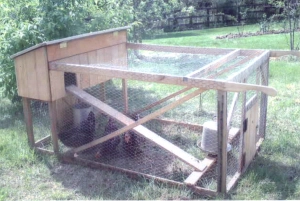
Chicken tractor, by Jasmine and Michael Courts
